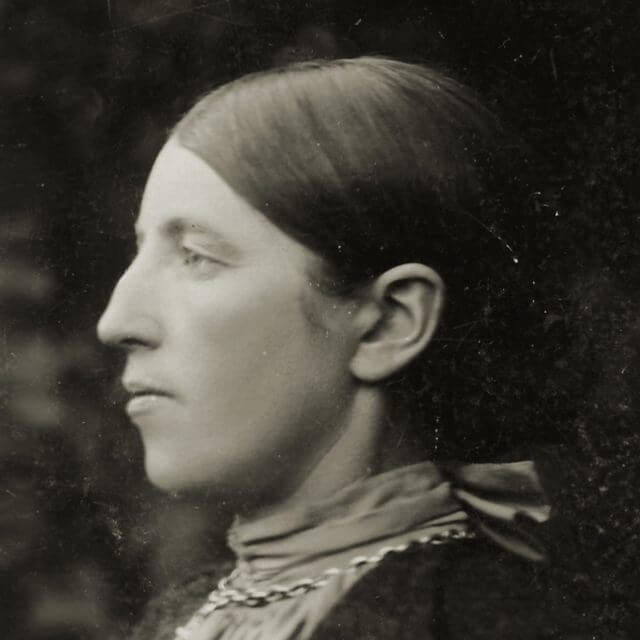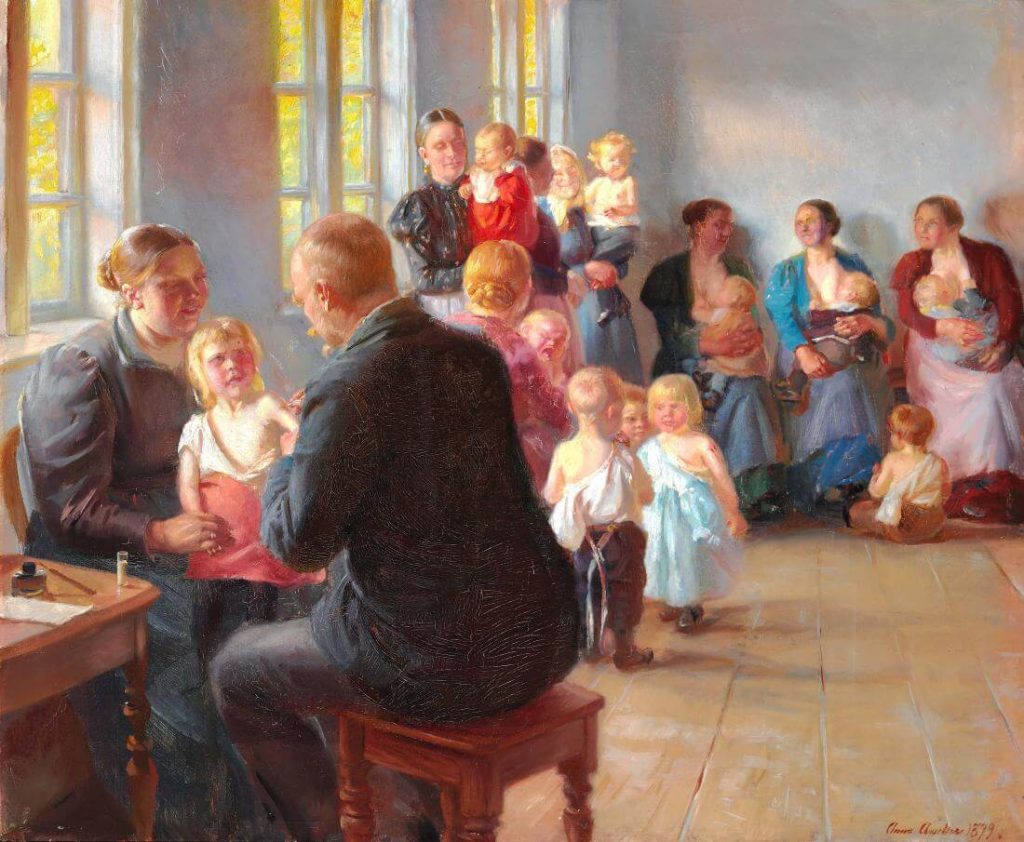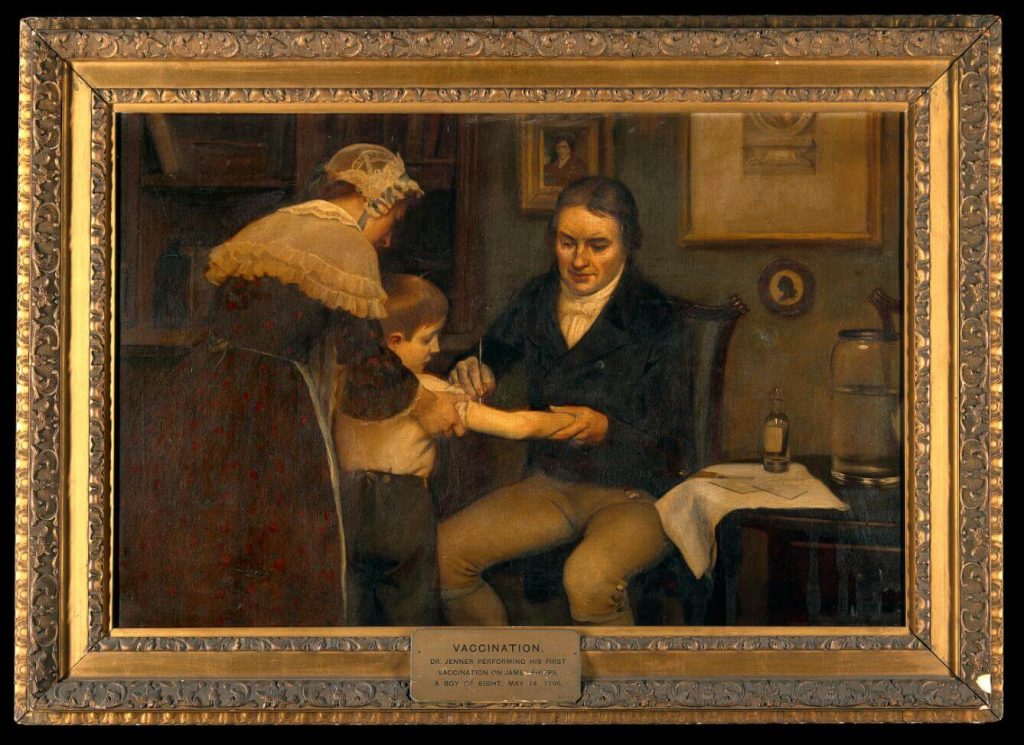Masterpiece Story: Portrait of Madeleine by Marie-Guillemine Benoist
What is the message behind Marie-Guillemine Benoist’s Portrait of Madeleine? The history and tradition behind this 1800 painting might explain...
Jimena Escoto 16 February 2025
Anna Ancher’s painting A Vaccination underlines the importance of vaccines for the community and how children are key elements in public health. It also celebrates advances in medical services. Let’s discover the history and technique of this masterpiece!
Anna Kirstine Ancher, nee Brøndum (1859-1935) was born, lived, and even died in Skagen. After some private painting lessons, during her adolescence, she attended the school of painting for women in Copenhagen. She married Michael Ancher, a local painter, in 1880. They had a daughter and decided to live in their own city until their deaths.
Anna became a recognized artist especially with the exhibition of Charlottenborg in Copenhagen in 1880, at only 21 years old. It must be noted that she succeeded in working as a woman in a typically male world, as the artistic environment was in her time. She usually represented real life in her culture, including some religious and health subjects.

Photograph of Anna Ancher, beginning of the 20th century, Skagen Museum, Skagen, Denmark.
A Vaccination was painted by Ancher in 1899 and immediately thereafter was exhibited at the annual Charlottenborg Spring Exhibition. The painting was a great success, not only for its characteristics but also because it had already been sold to a Swedish match manufacturer’s private collection even before the exhibition. This was very unusual for the time and in particular for Ancher, so much so that it was even mentioned in the newspapers.
Moreover, scenes of medical procedures and especially of vaccinations were quite frequently seen in European culture at the time, since the smallpox vaccine became widespread and in some areas, vaccines were even mandatory. So, when Anna Ancher presented this work, the theme was already well-known by critics and was no longer controversial.
Since 2013 the painting has been on display at the Skagen Museum in Denmark. Until that year it remained private property, only known from and described in documents such as letters, studies, and black-and-white photographs.
In 2020-2021, a retrospective exhibition about Ancher was organized at the Statens Museum for Kunst (Copenhagen, Denmark), Skagens Museums (Skagen, Denmark) and Lillehammer Kunstmuseum (Lillehammer, Norway). It was the largest exhibition about the artist to date and A Vaccination was included in the theme “Community.”

Anna Ancher, A Vaccination, 1899, Skagen Museum, Skagen, Denmark.
Ancher did many studies for this work, experimenting with colors and testing various compositional elements. She also probably sketched on-site during vaccination clinics, as can be read from letters sent between her and her mother.
In the definitive version, she added movement, distributing both standing and sitting figures. Moreover, she added windows. These are fundamental in the artist’s oeuvre since they are the source of light both for the representation and the real subject. In other words, Ancher used them to illuminate the scene of her painting, but the doctor also needed light in real life in the room to be able to see while performing his work.
The final work includes a doctor in the foreground with his back to the observer. He is about to inject a little girl on her mother’s lap. Another woman in a pink dress is sitting just behind them, surrounded by three kids and with another very little one in her arms. Three more women are standing just in front of the windows with their children, and yet another three women sit in the background, speaking while breastfeeding. Some children are waiting for vaccinations while others have already received it.
The corner of a small table is visible on the left. This is likely where the doctor prepares the injections and records the names of the already vaccinated children. It is thought to be a local scene, i.e. the children belong to the local fishermen of Skagen. They are probably being vaccinated against smallpox. This was the first ever vaccine, created by Edward Jenner. In fact, at the time children had to be vaccinated before their 7th birthday and in Denmark the vaccination became mandatory in 1810.
The painting features vivid colors, luminous environment, and a certain quality of technique. The critics of the time, as well as contemporary ones, defined the painting as “exquisite in color, amusing, enjoyable, superior, and successful”.
As previously mentioned, this work is often considered in the theme of “community”, or “everyday life”. This may lead us to think that there was not a medical significance within the painting, but only a new aspect, a variation on the usual themes of Anna Ancher – social subjects and life in Skagen, which also included visits to the doctor.
Actually, there are probably more levels of significance. Nowadays, we rediscover this painting for its meanings and roles, that can be both similar and different to those of more than a century ago. Ancher may have meant to represent the advance of medical sciences in her time, a subject also visible in many other European painters’ works. In a sense, this Danish masterpiece could be a celebration of medicine among similar ones from across the whole continent.

Ernest Board, Dr Jenner Performing his First Vaccination, 1796, Wellcome Collection, London, UK. Museum’s website.
However, Ancher surely wanted to represent social life and responsibility towards collectivity. Only a single reviewer at the beginning of the 20th century pointed out this social aspect, enhancing how vaccination is an expression of being aware of social responsibility. In fact, being vaccinated benefits not only the recipient but also the entire community.
Moreover, the painter underlines how children are an essential part of public health and, perhaps, suggests how these “next-generation adults” will be responsible for others again in their time.
Last but not least, the title does not include any reference to a specific event, place, or situation. The model for the doctor could have been Ancher’s husband, Michael. This probably indicates that it was not important who the doctor was, but that he was a doctor performing vaccinations. In other words, this work is the portrait of a general (and generable) situation – a vaccination. The subject is unique in Ancher’s career. She never painted any other medical subject again, and just a few other times did she represent so many figures. This painting includes quite a large number and variety of figures, however, her pieces were generally smaller and more intimate, portraying only one or two people.
Nowadays, the painting could be seen as emblem of both advances in public health and social responsibility. It even has acquired a stronger value during the COVID-19 pandemic. It reminds us to get vaccinated for ourselves and, of course, for the whole community.
Jensen, Mette Bøgh. A Jab of Relief. Anna Ancher’s ‘A Vaccination.’ Perspective. Accessed 28 Mar 2022.
DailyArt Magazine needs your support. Every contribution, however big or small, is very valuable for our future. Thanks to it, we will be able to sustain and grow the Magazine. Thank you for your help!